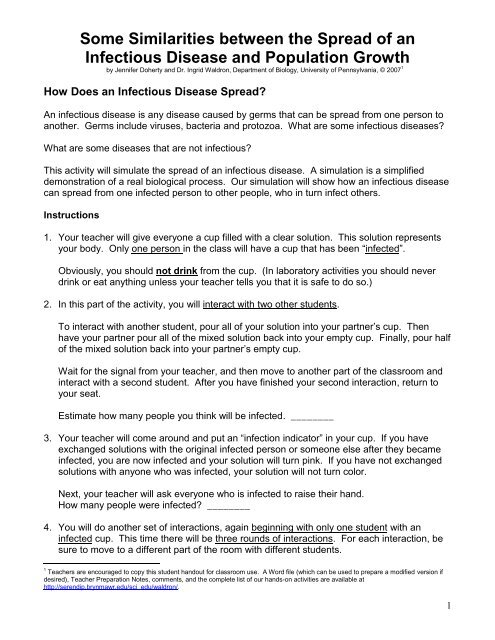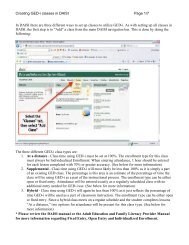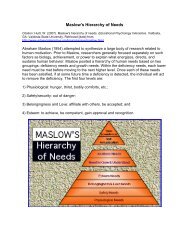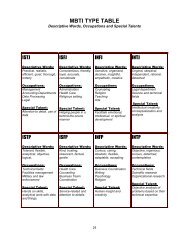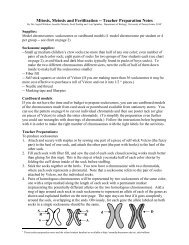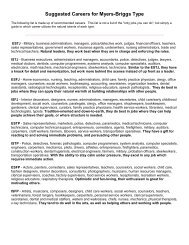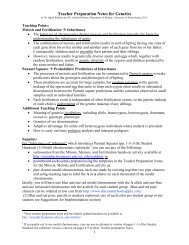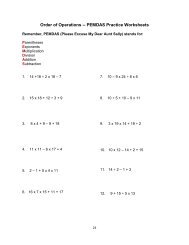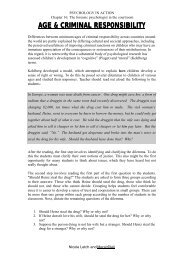List the ways that diseases are transmitted from one person to another
List the ways that diseases are transmitted from one person to another
List the ways that diseases are transmitted from one person to another
You also want an ePaper? Increase the reach of your titles
YUMPU automatically turns print PDFs into web optimized ePapers that Google loves.
Some Similarities between <strong>the</strong> Spread of an<br />
Infectious Disease and Population Growth<br />
by Jennifer Doherty and Dr. Ingrid Waldron, Department of Biology, University of Pennsylvania, © 2007 1<br />
How Does an Infectious Disease Spread?<br />
An infectious disease is any disease caused by germs <strong>that</strong> can be spread <strong>from</strong> <strong>one</strong> <strong>person</strong> <strong>to</strong><br />
ano<strong>the</strong>r. Germs include viruses, bacteria and pro<strong>to</strong>zoa. What <strong>are</strong> some infectious <strong>diseases</strong>?<br />
What <strong>are</strong> some <strong>diseases</strong> <strong>that</strong> <strong>are</strong> not infectious?<br />
This activity will simulate <strong>the</strong> spread of an infectious disease. A simulation is a simplified<br />
demonstration of a real biological process. Our simulation will show how an infectious disease<br />
can spread <strong>from</strong> <strong>one</strong> infected <strong>person</strong> <strong>to</strong> o<strong>the</strong>r people, who in turn infect o<strong>the</strong>rs.<br />
Instructions<br />
1. Your teacher will give every<strong>one</strong> a cup filled with a clear solution. This solution represents<br />
your body. Only <strong>one</strong> <strong>person</strong> in <strong>the</strong> class will have a cup <strong>that</strong> has been “infected”.<br />
Obviously, you should not drink <strong>from</strong> <strong>the</strong> cup. (In labora<strong>to</strong>ry activities you should never<br />
drink or eat anything unless your teacher tells you <strong>that</strong> it is safe <strong>to</strong> do so.)<br />
2. In this part of <strong>the</strong> activity, you will interact with two o<strong>the</strong>r students.<br />
To interact with ano<strong>the</strong>r student, pour all of your solution in<strong>to</strong> your partner’s cup. Then<br />
have your partner pour all of <strong>the</strong> mixed solution back in<strong>to</strong> your empty cup. Finally, pour half<br />
of <strong>the</strong> mixed solution back in<strong>to</strong> your partner’s empty cup.<br />
Wait for <strong>the</strong> signal <strong>from</strong> your teacher, and <strong>the</strong>n move <strong>to</strong> ano<strong>the</strong>r part of <strong>the</strong> classroom and<br />
interact with a second student. After you have finished your second interaction, return <strong>to</strong><br />
your seat.<br />
Estimate how many people you think will be infected. ________<br />
3. Your teacher will come around and put an “infection indica<strong>to</strong>r” in your cup. If you have<br />
exchanged solutions with <strong>the</strong> original infected <strong>person</strong> or some<strong>one</strong> else after <strong>the</strong>y became<br />
infected, you <strong>are</strong> now infected and your solution will turn pink. If you have not exchanged<br />
solutions with any<strong>one</strong> who was infected, your solution will not turn color.<br />
Next, your teacher will ask every<strong>one</strong> who is infected <strong>to</strong> raise <strong>the</strong>ir hand.<br />
How many people were infected? ________<br />
4. You will do ano<strong>the</strong>r set of interactions, again beginning with only <strong>one</strong> student with an<br />
infected cup. This time <strong>the</strong>re will be three rounds of interactions. For each interaction, be<br />
sure <strong>to</strong> move <strong>to</strong> a different part of <strong>the</strong> room with different students.<br />
1 Teachers <strong>are</strong> encouraged <strong>to</strong> copy this student handout for classroom use. A Word file (which can be used <strong>to</strong> prep<strong>are</strong> a modified version if<br />
desired), Teacher Preparation Notes, comments, and <strong>the</strong> complete list of our hands-on activities <strong>are</strong> available at<br />
http://serendip.brynmawr.edu/sci_edu/waldron/.<br />
1
Estimate how many people you think will be infected after each student has interacted with<br />
three o<strong>the</strong>r students. ________<br />
After <strong>the</strong> teacher has come around with <strong>the</strong> indica<strong>to</strong>r, write down how many people were<br />
actually infected. ________<br />
5. Now you will graph how an infection spreads with increasing numbers of interactions.<br />
First, plot a point <strong>to</strong> indicate <strong>that</strong> <strong>one</strong> <strong>person</strong> was infected before any interactions.<br />
How many people would be infected after just <strong>one</strong> interaction? ________<br />
Add this point <strong>to</strong> your graph.<br />
Next, plot <strong>the</strong> number of people who were infected after two interactions (<strong>from</strong> 3 on page 1)<br />
and <strong>the</strong> number of people who were infected after three interactions (<strong>from</strong> 4 on pages 1-2).<br />
Discussion<br />
6. Did <strong>the</strong> number of people infected increase by <strong>the</strong> same amount for interaction 1,<br />
interaction 2, and interaction 3?<br />
Which interaction resulted in <strong>the</strong> smallest increase in <strong>the</strong> number of infected people?<br />
Which interaction resulted in <strong>the</strong> largest increase in <strong>the</strong> number of infected people?<br />
In each interaction, each infected <strong>person</strong> can infect <strong>one</strong> new <strong>person</strong>. Therefore an<br />
interaction <strong>that</strong> begins with more infected people will generally result in more new<br />
infections.<br />
2
7. How many people do you think would be infected if you had four interactions? ________<br />
8. How many people do you think would be infected if you had ten interactions? ________<br />
After <strong>the</strong> tenth interaction, would <strong>the</strong> rate of increase in <strong>the</strong> number of infected people<br />
become faster or slower? Explain why.<br />
9. What <strong>are</strong> some <strong>ways</strong> <strong>that</strong> infectious <strong>diseases</strong> <strong>are</strong> <strong>transmitted</strong> <strong>from</strong> <strong>one</strong> <strong>person</strong> <strong>to</strong> ano<strong>the</strong>r?<br />
10. What <strong>are</strong> some <strong>ways</strong> you can prevent <strong>the</strong> spread of an infectious disease?<br />
11. Our simulation showed <strong>the</strong> way a disease could spread if <strong>the</strong> spread of disease depends<br />
on <strong>person</strong>-<strong>to</strong>-<strong>person</strong> contact. Examples of this kind of disease include pink eye,<br />
chickenpox and herpes (lip sores). O<strong>the</strong>r <strong>diseases</strong>, such as colds and tuberculosis, can be<br />
spread by germs in <strong>the</strong> air. How might <strong>the</strong> spread of <strong>the</strong>se <strong>diseases</strong> differ <strong>from</strong> <strong>the</strong> spread<br />
of <strong>diseases</strong> <strong>that</strong> depend on <strong>person</strong>-<strong>to</strong>-<strong>person</strong> contact?<br />
12. The spread of <strong>the</strong> disease in our simulation was very rapid. Multiple people were infected<br />
within a few minutes. In real life, infections do not spread as rapidly as in this simulation.<br />
Why is <strong>the</strong> spread of infections slower in real life?<br />
13. In addition <strong>to</strong> exposure <strong>to</strong> germs or pathogens, what o<strong>the</strong>r fac<strong>to</strong>rs influence your risk of<br />
getting an infectious disease? What defenses does your body have <strong>that</strong> can prevent you<br />
<strong>from</strong> getting sick, even when you have been exposed <strong>to</strong> a pathogen?<br />
14. Once you have caught a cold or flu, you do not stay sick forever. How does your body<br />
eventually get rid of <strong>the</strong> viruses <strong>that</strong> cause a cold or flu?<br />
15. A <strong>person</strong> who becomes infected with <strong>the</strong> HIV virus is not able <strong>to</strong> get rid of <strong>the</strong> HIV virus.<br />
With highly effective modern medical treatment, a <strong>person</strong> may survive a long time with an<br />
HIV infection, but an untreated HIV-infected individual is very likely <strong>to</strong> develop AIDS and<br />
die. Why is a <strong>person</strong> with an HIV infection unable <strong>to</strong> get rid of this infection <strong>the</strong> way a<br />
<strong>person</strong> can get rid of an infection with a cold or flu virus?<br />
Population Growth<br />
There <strong>are</strong> some interesting similarities between <strong>the</strong> spread of infectious <strong>diseases</strong> and<br />
population growth, e.g., <strong>the</strong> increase in <strong>the</strong> number of bacteria, plants or animals in a<br />
population. For example, in a growing population of bacteria, each bacterium can give rise <strong>to</strong><br />
two new bacteria after about 30 minutes. This results in a doubling of <strong>the</strong> number of bacteria<br />
every 30 minutes, which is similar <strong>to</strong> <strong>the</strong> doubling in <strong>the</strong> number of infected people after <strong>the</strong><br />
first and second rounds of interactions in <strong>the</strong> spread of infectious disease activity.<br />
Suppose a single bacterium is placed on an agar plate and <strong>the</strong> number of bacteria in <strong>the</strong><br />
population doubles every 30 minutes. How long do you think it would take before <strong>the</strong>re would<br />
be 1000 bacteria?<br />
3
Number of Bacteria<br />
To calculate how long it would actually take for <strong>the</strong> single bacterium <strong>to</strong> multiply <strong>to</strong> form a<br />
colony of 1000 bacteria, fill in <strong>the</strong> number of bacteria at each time in <strong>the</strong> table.<br />
1 bacterium at <strong>the</strong> beginning<br />
bacteria after 30 minutes<br />
bacteria after 1 hour<br />
bacteria after 1 hour and 30 minutes<br />
bacteria after 2 hours<br />
bacteria after 2 hours and 30 minutes<br />
bacteria after 3 hours<br />
bacteria after 3 hours and 30 minutes<br />
bacteria after 4 hours<br />
bacteria after 4 hours and 30 minutes<br />
bacteria after 5 hours<br />
How long would it take for <strong>the</strong> population of bacteria <strong>to</strong> increase <strong>from</strong> 1 bacterium <strong>to</strong> 500<br />
bacteria?<br />
How long would it take for <strong>the</strong> population of bacteria <strong>to</strong> increase <strong>from</strong> 500 bacteria <strong>to</strong> 1000<br />
bacteria?<br />
Notice <strong>that</strong>, when a population doubles every 30 minutes, <strong>the</strong> number of bacteria in <strong>the</strong><br />
population increases faster and faster as <strong>the</strong> population gets larger.<br />
This kind of population growth is called exp<strong>one</strong>ntial growth.<br />
To see what exp<strong>one</strong>ntial growth looks like in a graph, use <strong>the</strong> data <strong>from</strong> <strong>the</strong> above table <strong>to</strong> plot<br />
<strong>the</strong> number of bacteria at each time in <strong>the</strong> graph.<br />
1000<br />
800<br />
600<br />
400<br />
200<br />
0<br />
0 1 2 3 4 5<br />
Hours<br />
4
Population Size<br />
If exp<strong>one</strong>ntial growth continued for 10 hours, <strong>the</strong> original single bacterium would increase <strong>to</strong> a<br />
population of over <strong>one</strong> million bacteria. This illustrates how exp<strong>one</strong>ntial growth can result in<br />
very rapid increase of population size.<br />
In <strong>the</strong> real world, no population of bacteria or any o<strong>the</strong>r biological organism can keep<br />
increasing exp<strong>one</strong>ntially forever. Why not?<br />
All organisms require resources such as water and nutrients <strong>to</strong> grow and reproduce. The<br />
environment where a population is growing has only a limited amount of resources. As <strong>the</strong><br />
population gets larger, <strong>the</strong>re will not be enough resources <strong>to</strong> support continued rapid growth of<br />
<strong>the</strong> population. The rate of growth of <strong>the</strong> population will slow down, and finally <strong>the</strong> population<br />
will reach a maximum size which is called <strong>the</strong> carrying capacity of <strong>the</strong> environment. This<br />
type of logistic growth curve is illustrated in <strong>the</strong> following figure. The first part of a logistic<br />
growth curve looks like an exp<strong>one</strong>ntial growth curve, but a logistic growth curve levels off as<br />
<strong>the</strong> population size approaches <strong>the</strong> _____________________________ of <strong>the</strong> environment.<br />
Logistic Growth<br />
Carrying capacity<br />
Time<br />
5


